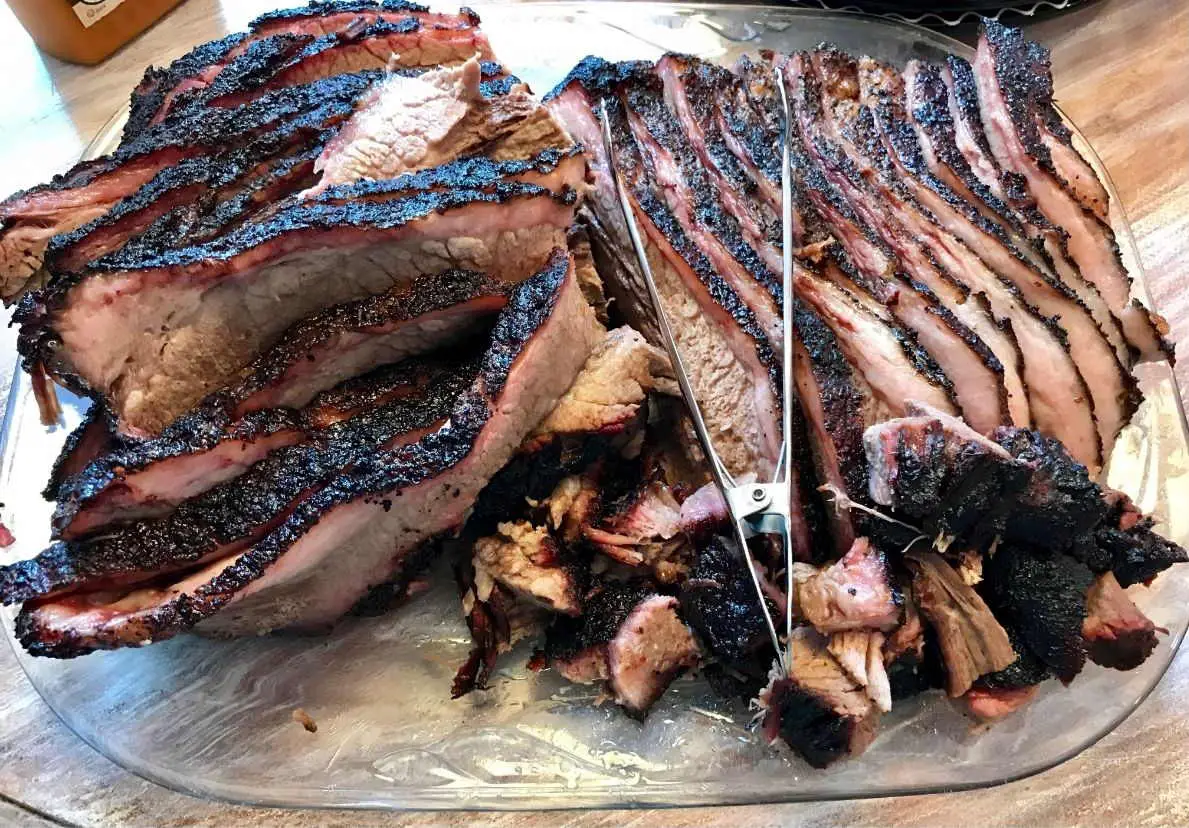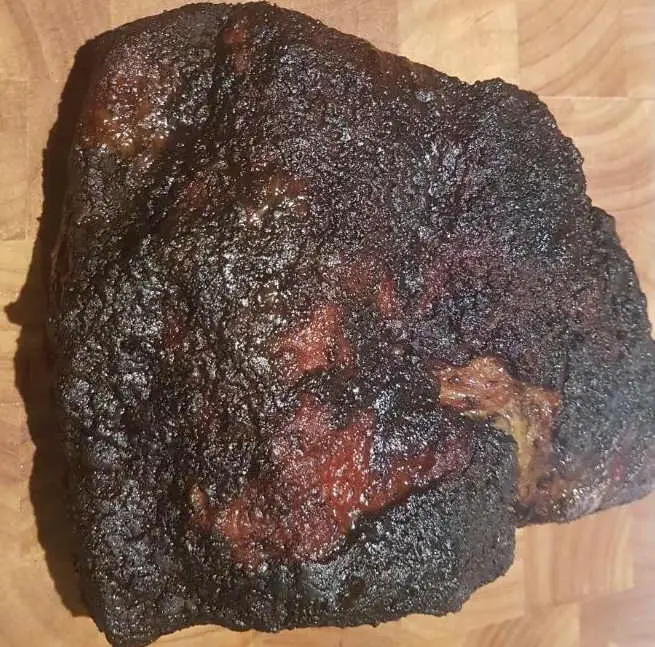
The beef brisket is a time-honored tradition of American culinary heritage. The quintessential BBQ recipe is a smoking hot favorite of smoked BBQ lovers the world over.
BBQ chefs and aficionados may ponder over what brisket size to smoke. This article will give you an idea of the right brisket size for smoking so that you can craft the perfect culinary delight that will meet the approval of even the most fickle BBQ connoisseurs.
How to Select the Best Size Brisket for Amazing Flavor
The best-sized beef brisket is 13 pounds untrimmed or 12 pounds trimmed for amazing flavor. Consistency is the deciding factor for flavor, not the size of your brisket. Buying a consistent size brisket every time can help give you better results over time.
Also, we like to purchase 13-pound briskets because the cattle should be roughly the same size, which could imply other consistencies like age and how the cattle were raised. Every variable you can eliminate will help you improve your brisket’s flavor on each cook.
When we say trimmed, we are looking for a fat layer of ¼ inch and all sharp edges and corners completely rounded off. This will result in good airflow around the brisket and the perfect amount of fat for a moist brisket.
Keep in mind the brisket size is not the bottom line when it comes to results. We have a lot of resources to help you smoke your meat, like our article Top 10 Budget-Friendly Hacks for Smoking Meat Like a Pro.
The Right Brisket Size For Your Party
You should consider how many people you will be serving so that you can arrive at the perfect size for your upcoming event.
One good rule of thumb is that you should allow about two pounds of raw meat per person. There should be enough brisket to go around, even for guests with the heartiest appetites.
So much meat per guest might sound like overkill, but it is quite a practical way of doing things. For one thing, there is virtually no danger of running out of beef brisket before your guests with the largest appetites are satiated.
What’s more, you will most likely have plenty of leftovers that you can enjoy the next day. A major regret of making great BBQ is not having enough to savor the next day. But with an abundance of meat, you will be able to create amazing sandwiches or brisket chili and reminisce the delights of your previous night’s BBQ party.
You will also make for a gracious host who believes in handing out generously large-sized servings to grateful guests. This is something that your guests will admire and appreciate long after the BBQ festivities are over. Feeding your guests and spoiling them with great BBQ till they can eat no more is a wonderful show of hospitality.
What Is the Best Cut of Meat for Beef Brisket?
For the best tasting beef brisket that will delight one and all, you should go for the highest grade meat that you can find. The higher the quality of brisket meat, the better the outcome of your hard work at the pellet smoker.
You can never go wrong by purchasing organic hormone-free beef, especially for the big occasion where you will be inviting relatives and friends. You can show genuine care for your guests and their well-being by using the best quality meat that aligns with a healthy lifestyle. Guests will appreciate the lengths to which you are going to please them.
The best cuts of meat are tender, fatty parts with plenty of moist, juicy goodness to tickle your taste buds.
While some chefs recommend remaining on the leaner side, it is not advisable to keep it excessively lean. Too much leanness can mean less flavor and tougher texture, which you don’t want in your BBQ meats.

What Cut Is Better, the Flat Cut or the Point Cut?
BBQ chefs often think about which cut of meat will be best for their brisket. Is it the flat cut or the point cut? The flat cut in the untrimmed state will do quite well for your beef brisket, as long as you cook it low and slow.
The good news is that finding the flat cut is a cinch since it is readily available at most supermarkets. The shape is flat, and there is a thin fat layer suitable for cooking brisket in a pellet smoker. The flat cut is also referred to as the first cut at many butcher shops.
The point cut is also a very decent choice. If you have a propensity for juicy, tender, and moist goodness, then the pointcut is sure to impress with its great fat content. Some butchers will refer to the point cut as the second cut.
The point cut is thick than the flat cut and has muscle fibers that run across the brisket, where the flat fibers run along with the brisket. Finally, the point is used to make burnt ends by chopping it into bite-size pieces after cooking them, then cooking it a bit more with a light bbq sauce.
Is Trimming the Fat a Good Idea for Your Beef Brisket?
Trim your beef brisket so there is a ¼ inch layer of soft fat on your brisket and round off any sharp edges or corners. Be sure when you place your brisket in your smoker the layer of fat upwards so your brisket will stay moist.
Removing too much fat means reducing the flavor and juicy goodness in your beef brisket. Of course, there is a certain optimum fat level that will suit the taste of different individuals. However, aggressively removing all fat is sure to backfire because you will wind up with a pretty bland-tasting BBQ.
You will find plenty of recommendations online that firmly call for removing most or all fat content from meats, but this is not the case for brisket. The plain simple truth is that you can cook superb-tasting beef brisket BBQ without removing any fat if you are willing to eat the fat.
The generous layer of fat can keep your BBQ moist and allow the cut to simmer in it during the cooking process. Your BBQ will develop a deep, subtle and rich taste by the time you take it out from the grill.
Excessively trimmed cuts of meat are about as appetizing as dog food. Not good when your BBQ reputation is at stake, and you are seeking nothing short of the best-tasting meal.
You will find that recipes calling for the leanest cuts almost always require an unholy amount of BBQ sauce, condiments, and flavoring. This is no coincidence. The trimming has stripped the meat of much of its flavor, and now it is time to compensate with a plethora of sauces and liquids to make it somewhat edible.
Is Grass-Fed Meat a Good Choice for Beef Brisket?
Grass-fed beef brisket is a statement of your healthy lifestyle choices because it has less saturated fats and more vitamins, including antioxidants. However, cooking grass-fed meat can be more challenging than conventionally raised meats because it will be leaner than a traditional cut of beef from your local market.
You will have to devote extra time to ensure that grass-fed meets the right level of tenderness. Make sure to marinate, inject, and baste your brisket to give you the best results. Additionally, you can make a judgment call with a fattie brisket, but when cooking a lean piece of beef, you always want to wrap it completely to seal in the juices after reaching 160 degrees.
You may have to remain patient if the grass-fed beef brisket takes a long time to cook properly. But do bear in mind that with persistence, the meat will eventually become tender. During the cook, you will have to keep an eye on liquid levels to ensure that the brisket turns out moist.
It is also a fine idea to support farms that exercise responsibility in raising animals so that you can have the healthiest possible meat on the table.
What Are the Tips for Cooking Kosher Brisket?
If you are using kosher brisket, then bear in mind that it is pre-salted. One guideline is to cut back the salt that you add by about a half. So you will have to take it easy on the salt or skip salted rubs altogether since the meat already has a fair bit of salt added in advance.
Another tip for a kosher brisket is to make a saltless brine.
- Take your favorite seasonings and add them to a large pan with a few cups of water.
- Bring them to a slow boil, then remove them from heat for an hour.
- Add one gallons of ice water, the kosher brisket, and place in your refrigerator overnight.
- Finally, cook as usual on your favorite smoker.
You can add a bit of table salt to the finished dish or sauce if you feel that more salt is necessary. But if you add too much salt, then you are out of luck.
Does Cooking in Advance Improve the Taste of Beef Brisket?
It is not a good idea to cook your beef brisket in advance of your meal because reheating a brisket can dry it out. But, you can prepare your brisket for cooking in advance. You may think about marinating or rubbing the brisket around 24 hours before smoking since this will allow time for the flavor to develop.
Keep the beef brisket in the refrigerator and let it rest so that the rich flavor penetrates the brisket’s tough fibers. When it is time to cook, you will have less work on your hands the day of your cook, plus your beef brisket will be infused with a richer taste.
Keep the beef brisket inside a ceramic dish, glass dish, or a food-safe container like Lexan. You may cover it with plastic wrap. Aluminum foil may not be a wise choice since the acid may react with the metal.
You will want to trim the extra fat from your beef brisket but don’t slice it at this point. Pour seasoned marinade all over the beef brisket so that it can marinate overnight.
When the big day finally arrives, take out the dish from the fridge and look for the fat on top. You might find that there is hardened fat over the surface. If so, carefully trim as little as possible.
Dry your brisket with a paper towel and lightly season with your usual rub mix. Next, smoke or bake your brisket low and slow as usual.
Conclusion
Our firm opinion is a 13-pound brisket is the best choice for amazing flavor. Our main reason for this conclusion is because of cooking consistency. Every time you cook any food item, you most likely up your game.
That being said, have fun with your cooking, and don’t stress out. Make what you enjoy and cook it the way you, your friends, and your family like.
Check out our How to use a Masterbuilt Electric Smoker: A Beginners Guide
